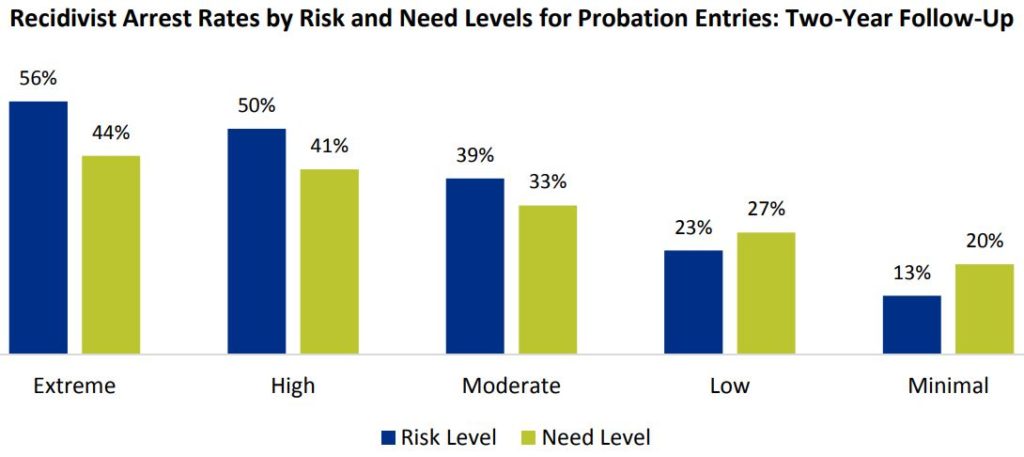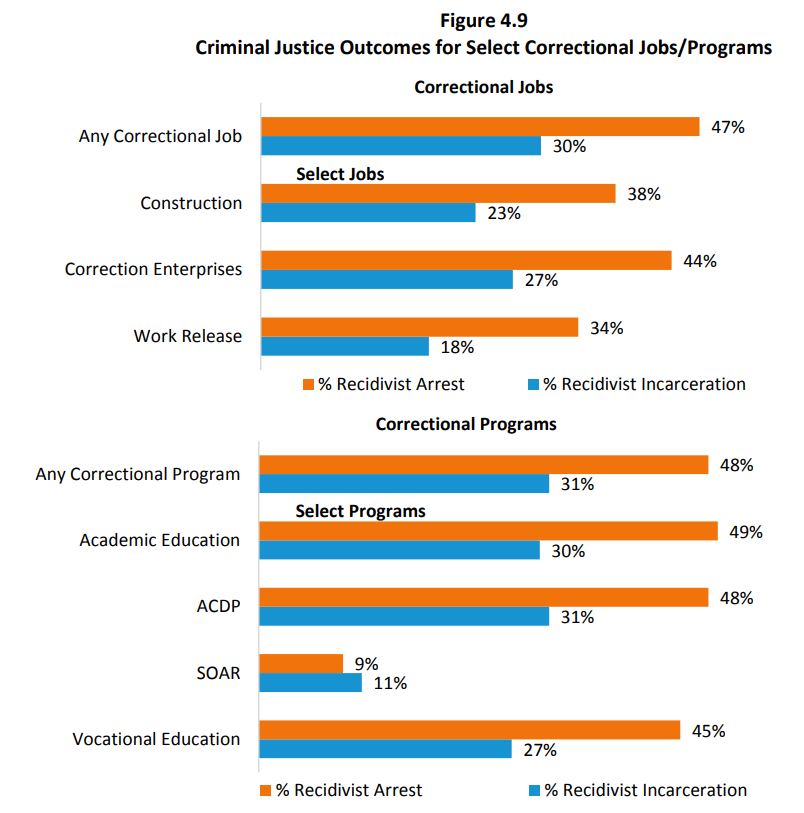The North Carolina Sentencing and Policy Advisory Commission recently released its biennial Correctional Program Evaluation—known better as the Recidivism Report. The report, prepared in conjunction with the Division of Adult Correction and Juvenile Justice, is available here. It covers defendants placed on probation or released from prison in Fiscal Year 2015.
As always, the report defines recidivism as an arrest, conviction, or subsequent incarceration during a two-year period after being placed on probation or released from imprisonment. The report covers 32,537 probation entries and 15,077 prison exits, picking the data apart in many interesting ways. Readers of this blog will definitely want to take a look at the full report. Here are a few my own observations.
Probationers holding steady. North Carolina’s overall recidivism rates for probationers remained largely unchanged. That’s an unremarkable statement, I suppose—except when you consider how much North Carolina law has changed since 2011. This year’s report follows a cohort of offenders who served their sentences under the new rules implemented by the Justice Reinvestment Act: revocation only for new crimes and absconding. It’s hard to control for all variables, but we can at least say that Justice Reinvestment allowed for a substantial reduction in North Carolina’s correctional population without causing a major spike in recidivist behavior by probationers.
Not so for low-level felony prisoners. The recidivist incarceration rate for prison inmates increased from 21 percent in FY 2013 to 32 percent in FY 2015. That increase is obviously driven by the fact that many more inmates are released to post-release supervision, and thus susceptible to having their PRS revoked. Those extra nine months built into every low level felony sentence—“just for post-release supervision,” the authors of Justice Reinvestment kept saying—turn out to be real months in prison for the supervisees who get revoked.
DAC risk needs assessment. The report confirms the value of the tools DAC uses to assess probationers’ risk of re-arrest (the Offender Traits Inventory–Revised, or OTI-R) and to grade their needs level. Some general background about Probation’s assessment process is here. As you can see in the figure below, recidivist arrest rates show a stair-step reduction as you move from the highest to lowest risk and needs. Probation’s supervision practices are based largely on the theory that that will be the case.

Program- and job-specific results. I am sometimes asked which prison programs a judge should recommend to help an inmate achieve the best possible long-term results. The figure below is helpful in answering that question. It shows that, on the whole, jobs (especially work release jobs in the community and construction jobs) do better than programs at reducing prisoners’ likelihood of being rearrested or reincarcerated. (The baseline rearrest rate for all prisoners is 49 percent; the baseline reincarceration rate is 32 percent.) For example, notice that inmates who participate in Alcoholism and Chemical Dependency Programs (ACDP) don’t move far below that baseline. An exception is the Sex Offender Accountability and Responsibility Program (SOAR) at Harnett Correctional Institution, which has the lowest recidivism rates of all by a wide margin.

Those are just some of the highlights. Thank you to the talented staff at the Sentencing Commission who prepare this important report.
Is there a control population that has zero programming? That seems awful in practice but it would be helpful to compare this data to. Thanks for this overview, it’s really useful.
In light of the infographic on page 21, this passage is worth mentioning since it debunks widespread misinformation about sex offender recidivism rates:
Offenders who are required to register as sex offenders under Article 27A of Chapter 14 of the NC
General Statutes are also a group of special interest. Those convicted of a reportable offense are
required to register as sex offenders. A reportable offense is defined as “an offense against a minor, a
sexually violent offense, or an attempt to commit” such offenses. Of the 927 offenders in the sample
convicted of an offense for which registration as a sex offender is required, 64% were prisoners and 36%
were probationers; 30% were convicted of a Class B1 – D felony, 59% of a Class E – G felony, 5% of Class
H – I felony, and 6% of a Class A1 – 3 misdemeanor.28 Overall, 24% of the offenders required to register
as a sex offender had a recidivist arrest, 11% had a recidivist conviction, and 27% had a recidivist
incarceration. Sex offenders generally had lower recidivism rates than most groups.
I beg to differ with you Mr. Yoder on numerous levels. Recidivism rates of sex offenders as indicated in this report are for those they are in contact with and have identified as such from prior conviction. You made an assumption that one cannot justify due to the following missing information: of those who have registered from an incarceration or conviction in NC how many have moved out of state which would then thin out the possible number of recidivists. Secondly, one does learn from their mistakes and from other prisoners on how to avoid detection which then also deflates the recidivism simply because they haven’t been caught….yet. Lastly, how many will be caught but not within the parameters of the evaluation such as type of offense or length of time from incarceration meaning they will but not within this time frame. Simply put you cannot say this debunks anything with missing information.